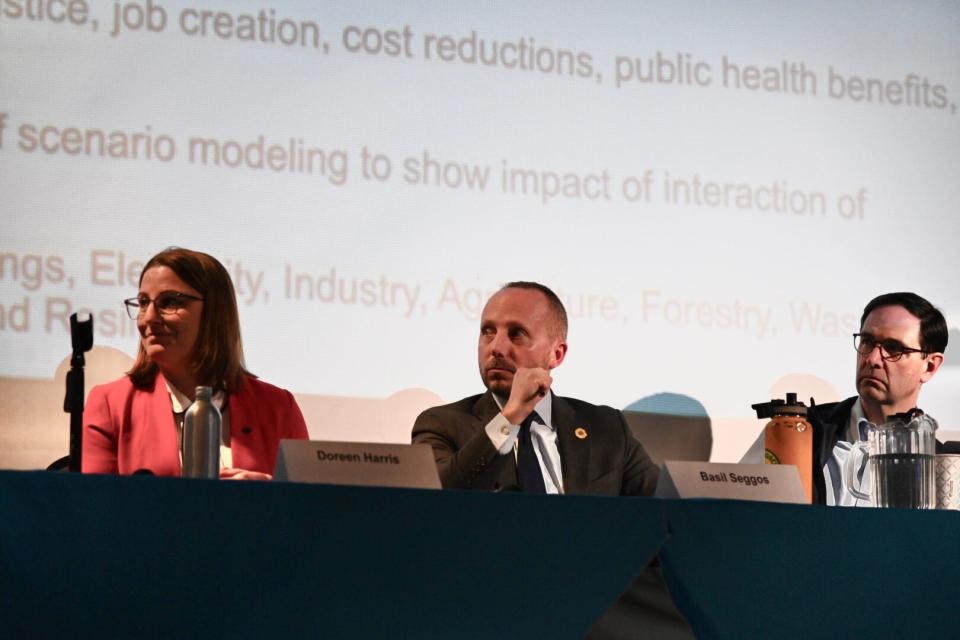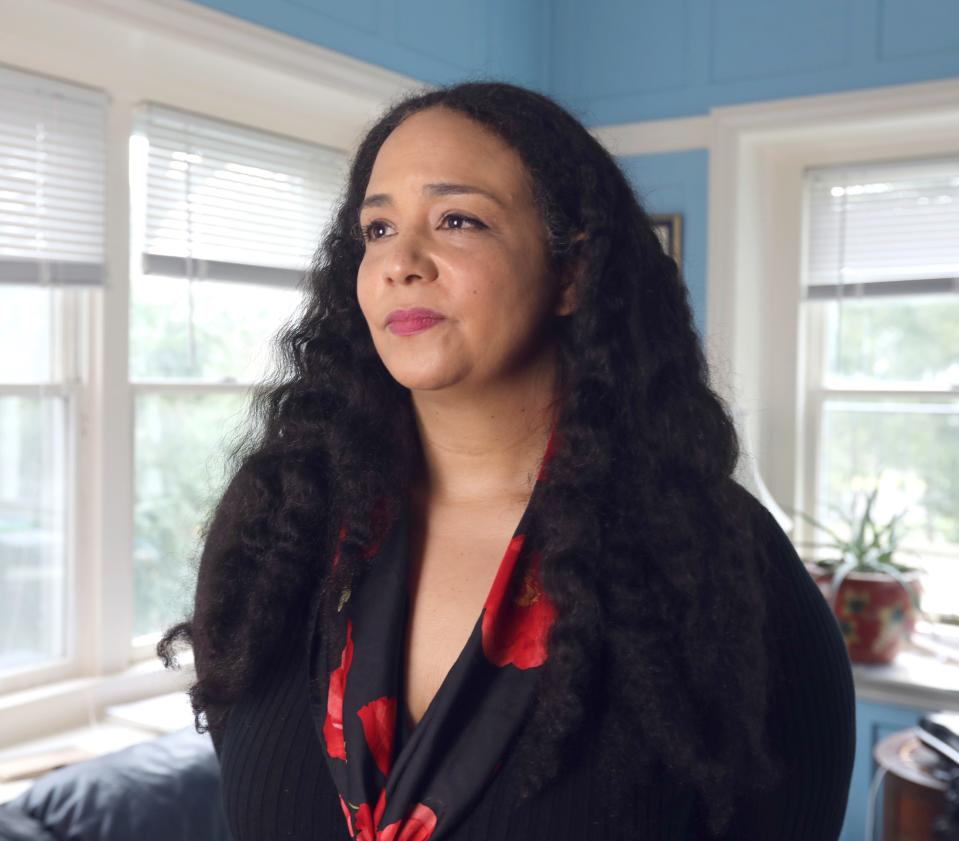New York passes climate plan to meet net-zero emissions by mid-century
New York’s landmark climate law cleared another hurdle Monday with a final plan to achieve net-zero emissions by mid-century.
The Climate Action Council, a state body, passed its final scoping plan to reduce the state’s greenhouse gas emissions by 85% by 2050, compared to 1990 levels, with carbon offsets — all while setting benefits toward communities most vulnerable to climate change. These goals were mandated under the 2019 Climate Leadership and Community Protection Act.
Upstate energySolar developers approached two NY farmers. Their choices reveal an industry in crisis
State agencies and legislators will be tasked with achieving requirements set by the law, considered the most sweeping climate legislation of any state:
By 2030, the state must have 70% renewable energy production and must reduce greenhouse gas emissions by 40%.
By 2040, the state must have 100% zero-emission electricity through sources such as solar, wind and improved battery storage.
By 2050, New York would arrive at net-zero emissions with offsets such as carbon sequestration.
The plan, passed 19-3 by the Climate Action Council, is expected to be sent to Gov. Kathy Hochul and the Legislature by the new year.
“Our climate act and the scoping plan can set an example to the world,” said Bob Howarth, a Cornell environmental biology and ecology professor who serves on the council, after his vote to support the plan. “I believe it will set an example to the world, as we work to address the existential threat of climate disruption.”
Climate alternatives'Climate negligence' bill could let New Yorkers sue fossil fuel companies. Here's how

What's the plan?
The plan recommends a “cap-and-invest program” akin to California’s cap-and-trade program. The policy would put a “cap” on total permitted emissions units, known as allowances. Polluting companies would then buy and sell a declining set of allowances — the “invest” — creating economic incentives for polluters to reduce emissions over time.
The plan also calls for billions of investments in reshaping buildings’ energy efficiency, which currently account for about a third of the state’s emissions, the highest of any sector. Between one and two million homes should transition to electric heat pumps by 2030, the report outlines.
Additionally, the plan calls for three million primarily electric vehicles by 2030 for transportation, the second highest emitting sector.
Along the way, the state climate law provides that at least 35% of benefits on clean energy and energy efficiency, with a goal of 40%, go to communities defined as disadvantaged. This includes communities of color and low-income communities located in areas that are often most vulnerable to the effects of climate change, and jobs that could be affected by the renewable energy transition.

'Complete magic'
Opponents of the plan worried about the transition away from fossil fuels that currently supply the bulk of the electric grid’s power. It’s also unclear how much the plan would cost individual New Yorkers.
“The scoping plan doesn’t go far enough to ensure a responsible energy future for New York consumers,” said Donna DeCarolis, president of the Western New York-based National Fuel Gas Distribution Corporation, one of three dissenting votes.
In her remarks, DeCarolis cited four reasons for dissenting: a lack of energy grid reliability for consumers; relying too heavily on electrification as a single form of energy prone to disruption by severe weather; consumer energy affordability; and the need to use existing natural gas systems, especially upstate with colder temperatures that require more heating.
While saying the 2030 goal for a 70% reduction in emissions is reachable, Gavin Donohue, president and CEO of the Independent Power Producers of New York, said the goal for 2040 — to achieve 100% zero-emissions electric — is “complete magic.”
He referred, in part, to the plan counting on a renewable energy source that hasn't been developed yet.
By 2050, the plan also estimates demand on the grid to double.
“The buildout that we’re talking about here is unbelievable,” Donohue said. “And this state has never seen a buildout like this.”
The council's plan said the cost of inaction is upwards of $115 billion caused by climate damages.
Costs of the law are expected to be around 0.6% of the state economy by 2030, and 1.3% by 2050, though Congress’ Inflation Reduction Act, considered the largest federal climate legislation, can help ameliorate expenses to reduce emissions, the plan said.
Early on, labor groups expressed concern in public hearings on the draft plan. The plan touts that new jobs created will ratio those lost 10-to-1 in 2030, adding hundreds of thousands of new jobs.
“We've been able to add substantial, significant labor protections and standards not only for the current workforce, but for generations to come,” said Mario Cilento, the president of the New York AFL-CIO, the state’s largest labor union organization, who supported the plan. Cilento joined the council in May when he was appointed by Hochul.
'The next step is to see it fully implemented'
Council member Raya Salter, a New Rochelle attorney who founded the Energy Justice Law and Policy Center, warned against “false solutions” such as nuclear and natural gas.
Howarth, of Cornell, said the plan better accounted greenhouse gas emissions that weren’t just carbon dioxide, but also methane, which the U.N. said has contributed to close to one-third of global warming since the Industrial Revolution. Methane is the primary compound in natural gas.

“Right now, New Yorkers pay some of the highest energy costs in the nation, including widely and wildly fluctuating costs for fossil gas in particular,” Salter said. “The scoping plan, however, provides a comprehensive approach to reaching the state's nation-leading climate goals, with a focus on justice and equity. The next step is to see it fully implemented.”
As a road map, the state plan will be updated at least once every five years. Regulators are also set to conduct inventories on greenhouse gas emissions as the state seeks net-zero emissions by 2050.
“I hear many statements that the world is looking at us,” said Doreen Harris, the council co-chair and the head of the state Energy Research and Development Authority. “I want to make sure that, in addition to this priority, the world is coming along with us.”
Eduardo Cuevas covers race and justice for the USA TODAY Network of New York. He can be reached at EMCuevas1@gannett.com and followed on Twitter @eduardomcuevas.
This article originally appeared on New York State Team: New York passes climate plan to meet net-zero emissions by mid-century

